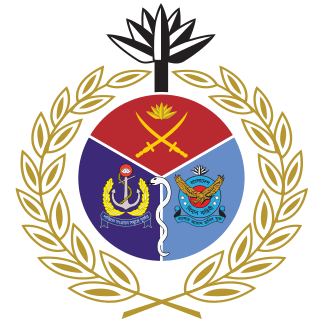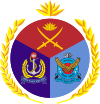
The Bangladesh Air Force (BAF) is the aerial warfare branch of the Bangladesh Armed Forces. The air force is primarily responsible for air defence of Bangladesh's sovereign territory as well as providing air support to the Bangladesh Army and Bangladesh Navy. Furthermore, the BAF has a territorial role in providing tactical and strategic air transport and logistics capability for the country.
The Ministry of Finance is a Cabinet-level ministry of the Government of Pakistan in charge of government finance, physical policy and financial regulation. It is headed by a Finance Minister, an executive or cabinet position. The Minister is responsible each year for presenting the federal government's budget to the Parliament of Pakistan.

The Bangladesh Army is the land warfare branch and the largest component of the Bangladesh Armed Forces. The primary mission of the Army is to provide necessary forces and capabilities, to deliver the Bangladeshi government's, adaptative security measures, modular strategies, and optimized or informed intelligence, used in prevision of defending the nation's territorial integrity against external attack. Control of personnel and operations is administered by the Army Headquarters, Dhaka. The Bangladesh Army is also constitutionally obligated to assist the government and it's civilian agencies, either during times of domestic national emergency, or as preventive measures in rare cases. This additional role is commonly referred to as "aid to civil administration" or, using the Latin form, "Protectio, Transparentia, Reintegratio", in others words, "Protect and Serve".

The Directorate General of Forces Intelligence, commonly known by its acronym DGFI, is the defense intelligence agency of the Bangladesh Armed Forces, tasked with collection, collation and evaluation of strategic and topographic information, primarily through human intelligence (HUMINT). As one of the principal members of the Bangladesh intelligence community, the DGFI reports to the Director-General under the executive authority of the head of government, the Prime Minister, and is primarily focused on providing intelligence for the Prime Minister, the Cabinet of Bangladesh, and the Armed Forces of Bangladesh.
A government budget or a budget is a projection of the government's revenues and expenditure for a particular period of time often referred to as a financial or fiscal year, which may or may not correspond with the calendar year. Government revenues mostly include taxes while expenditures consist of government spending. A government budget is prepared by the Central government or other political entity. In most parliamentary systems, the budget is presented to the legislature and often requires approval of the legislature. Through this budget, the government implements economic policy and realizes its program priorities. Once the budget is approved, the use of funds from individual chapters is in the hands of government ministries and other institutions. Revenues of the state budget consist mainly of taxes, customs duties, fees and other revenues. State budget expenditures cover the activities of the state, which are either given by law or the constitution. The budget in itself does not appropriate funds for government programs, hence need for additional legislative measures. The word budget comes from the Old French bougette.
The 2009 Union budget of India was presented by the finance minister, Pranab Mukherjee, on 6 July 2009.
The 2010 Union budget of India was presented by Finance minister Pranab Mukherjee in the Lok Sabha on Friday, February 26, 2010.
The Pakistan federal budget of 2009–2010 has been prepared in accordance with the budgeting and accounting classification system that has been approved by the Government of Pakistan as an integral part of the New Accounting Model. This is the first year the federal budget is being prepared using the newly adopted Medium-Term budgetary Framework (MTBF). Under this method macro projections are made over a rolling 3-year budgetary horizon. This year, expenditure ceilings were issued to Ministries on recurrent budget after Cabinet's approval, in line with the Government's stated priorities.
The Chilean Law N° 13.196 known as Ley Reservada del Cobre was a highly controversial secret law issued on 29 October 1958 under the administration of Carlos Ibáñez del Campo in order to allocate revenues from the copper mining corporations for the purchase and maintenance of Materiel of the Chilean armed forces. The law was replaced in 2019, with the armed forces' finances scheduled to come under the national budget by 2029.

The military budget or defence budget of India is the portion of the overall budget of Union budget of India that is allocated for the funding of the Indian Armed Forces. The military budget finances employee salaries and training costs, maintenance of equipment and facilities, support of new or ongoing operations, and development and procurement of new technologies, weapons, equipment, and vehicles.

Forces Goal 2030 is a military modernization program which began in 2009 and was revised in 2017. It was designed to enhance the capabilities of three service branches of Bangladesh Armed Forces: the Army, the Navy and the Air Force. The primary focus of the modernization program is the reformation of the military organization, expansion of the forces, the transformation of the indigenous defense sector to support research and manufacturing, and acquisition of modern military weapons. The requirement for modernization was realized in the aftermath of 2008 Bangladesh–Myanmar naval standoff later resulting in Bangladesh's favour. One of the primary objectives of the modernization program is to develop a three-dimensional force capable of conducting multi-platform warfare.

The defence industry sector of India is a strategically important sector in India. India has one of the world's largest military forces with a strength of over 1.44 million active personnel. The country has the world's largest volunteer military of over 5.1 million personnel. The total budget sanctioned for the Indian military for the financial year 2021 is ₹4.78 lakh crore. It has the third largest annual defence budget behind USA and China. It is the second largest defence importer behind Saudi Arabia making up 9.2% of global arms import. India has a domestic defence industry of which 60% is government owned. The public sector includes NTRO, CSIR, PRL, DRDO and its 50 labs, 4 defence shipyards, 12 defence public sector undertakings (PSUs). India has a new defence procurement, acquisition and manufacturing policy to reduce imports and enhance domestic manufacturing.
The 2017 Union Budget of India is the
Sheikh Hasina Cantonment is the headquarters of 7th Infantry Division of Bangladesh Army. It is located in Lebukhali, Barishal. The area of the cantonment is 1532 acres. The project will be completed by the Ministry of Defence by June 2021.

Dhaka Subway is an underground urban rail network being planned in Dhaka, the capital city of Bangladesh, by the Bangladesh Bridge Authority. Dhaka Subway was conceived as a separate transport system to the Dhaka Mass Rapid Transit network, commonly known as Dhaka Metro Rail.
The 2021 Union Budget of India was presented by the Minister of Finance on 1 February 2021. The budget is the first one to be presented orally due to ongoing COVID pandemic.

Directorate General of Medical Services is a Bangladesh government body under the Ministry of Defence responsible for overseeing the medical services of the defence forces. It is one of seven departments under the Ministry of Defence. The Directorate General of Medical Services provides grading and classification of plans and policies for overall health and medical care for the Armed Forces, annual planning, procurement and control of medical stores and equipment, advanced training of AMC, ADC and AFNS officers at home and abroad and expert pool control.
The 2021 National budget of Bangladesh was presented by the Minister of Finance Mustafa Kamal on 3 June 2021. The National budget is for the fiscal year beginning on 1 July 2021, and ending on 30 June 2022. The budget was the second to be presented amid the Coronavirus pandemic.

The defence industry of Bangladesh is a strategically important sector and a large employer in Bangladesh.The Government of Bangladesh is actively seeking to upgrade its military and security capabilities and has allocated increasing amounts to its defense and security-related budget.
The 2022 National budget of Bangladesh was presented by Minister of Finance AHM Mustafa Kamal on 9 June 2022. The budget is for the fiscal year beginning on 1 July 2022, and ending on 30 June 2023. The budget was the 14th presented by the Awami League-led Grand Alliance of Prime Minister Sheikh Hasina since returning to office in 2009. The budget was the third to be presented since the outbreak of the COVID-19 pandemic and focused primarily on economic recovery from the pandemic and ameliorating the impact of rising inflation as a result of the Russo-Ukrainian War.










